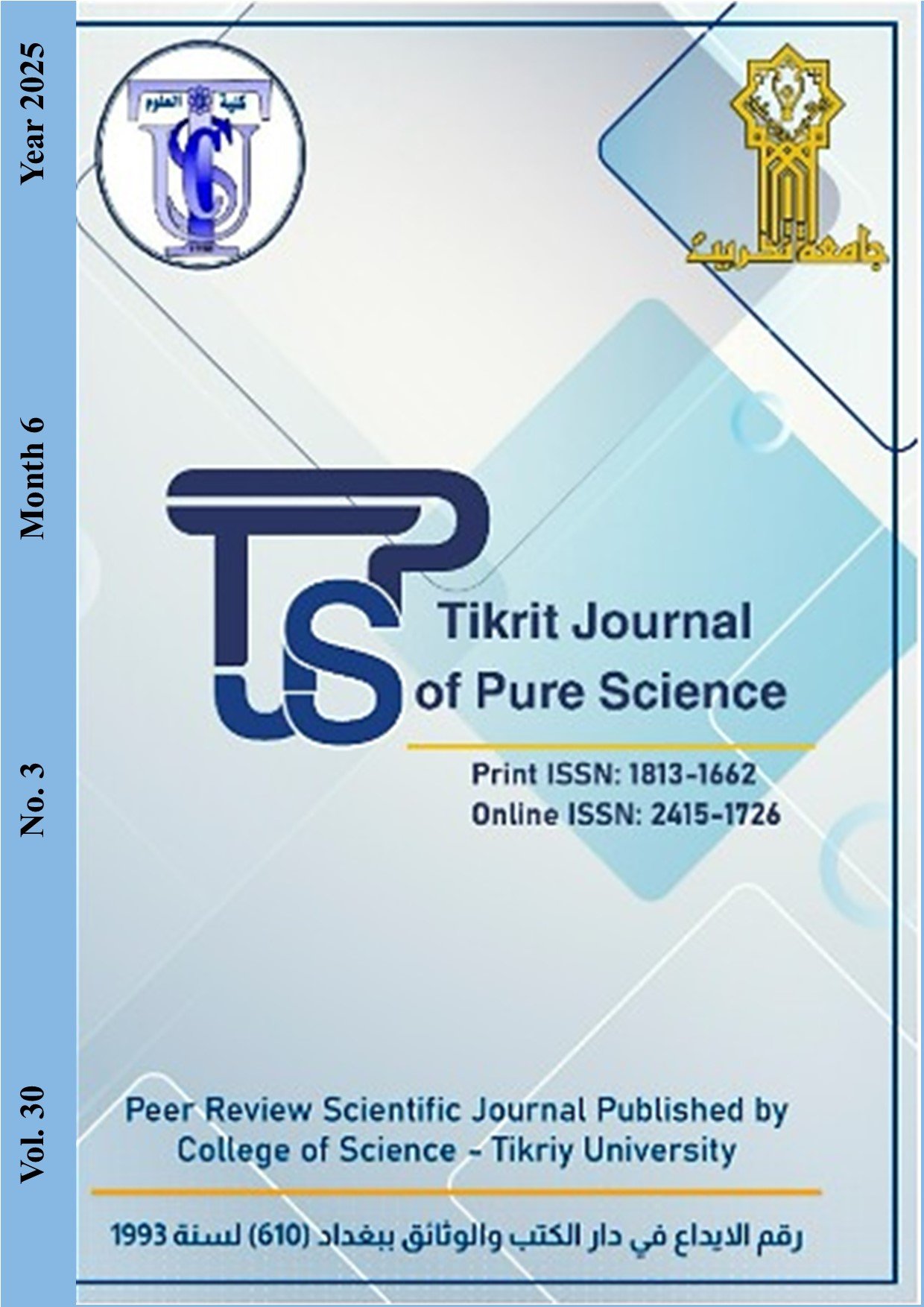Study of Dynamical Behavior of a Prey-Predator Model when the Prey Population Affected by Multifactor
Main Article Content
Abstract
In this work, a prey-predator model with Holling type II functional response is considered. The proposed model incorporates the cost of the fear of predators in prey, effect of environmental pollution and harvesting on prey population. Firstly, the details of model derivation of are given and then some of behaviors of the model solutions are proved, the existence criteria for each of the model equilibrium points are determined. For each of the equilibrium point, the sufficient and necessary conditions for being locally asymptotically stable are found. Via Lyapunov method, the sufficient conditions for global stability of the model equilibrium point are determined. Some numerical simulations are performed to discover the impact of the fear, harvesting population and environmental pollution on prey dynamics.
Article Details

This work is licensed under a Creative Commons Attribution 4.0 International License.
Tikrit Journal of Pure Science is licensed under the Creative Commons Attribution 4.0 International License, which allows users to copy, create extracts, abstracts, and new works from the article, alter and revise the article, and make commercial use of the article (including reuse and/or resale of the article by commercial entities), provided the user gives appropriate credit (with a link to the formal publication through the relevant DOI), provides a link to the license, indicates if changes were made, and the licensor is not represented as endorsing the use made of the work. The authors hold the copyright for their published work on the Tikrit J. Pure Sci. website, while Tikrit J. Pure Sci. is responsible for appreciate citation of their work, which is released under CC-BY-4.0, enabling the unrestricted use, distribution, and reproduction of an article in any medium, provided that the original work is properly cited.
References
1. Fatah S, Mustafa A, Amin S. Predator and n-classes-of-prey model incorporating extended Holling type II functional response for n different prey species. AIMS MATHEMATICS. 2023;8(3):5779-88. https://doi.org/10.3934/math.202329
2. He M, Li Z. Stability of a fear effect predator–prey model with mutual interference or group defense. Journal of Biological Dynamics. 2022;16(1):480-98. https://doi.org/10.1080/17513758.2022.2091800
3. Zanette LY, White AF, Allen MC, Clinchy M. Perceived predation risk reduces the number of offspring songbirds produce per year. Science. 2011;334(6061):1398-401. https://doi.org/10.1126/science.1210908
4. Cong P, Fan M, Zou X. Dynamics of a three-species food chain model with fear effect. Communications in Nonlinear Science and Numerical Simulation. 2021;99:105809. https://doi.org/10.1016/j.cnsns.2021.105809
5. Jamil ARM, Naji RK. Modeling and Analyzing the Influence of Fear on the Harvested Modified Leslie-Gower Model. Baghdad Science Journal. 2023;20(5):1701-. https://dx.doi.org/10.21123/bsj.2023.ID
6. Muhammed JO, Hassan KA. Bifurcation Analysis in a Discrete-Time Prey-Predator System with Crowly-Martin Functional Response. Tikrit Journal of Pure Science. 2023;28(5):129-46. https://doi.org/10.25130/tjps.v28i5.1588
7. Naji RK, Mustafa AN. The dynamicics of a prey-predator model with the existence of disease and pollution. J Math Comput Sci. 2013;3(1):94-123.
8. Pal S, Pal N, Samanta S, Chattopadhyay J. Effect of hunting cooperation and fear in a predator-prey model. Ecological Complexity. 2019;39:100770. https://doi.org/10.1016/j.ecocom.2019.100770
9.Tan Y, Cai Y, Yao R, Hu M, Wang W. Complex dynamics in an eco-epidemiological model with the cost of anti-predator behaviors. Nonlinear Dynamics. 2022;107(3):3127-41. https://doi.org/10.1007/s11071-021-07133-4
10. Wang X, Zanette L, Zou X. Modelling the fear effect in predator–prey interactions. Journal of mathematical biology. 2016;73(5):1179-204. https://doi.org/10.1007/s00285-016-0989-1
11. Zhang H, Cai Y, Fu S, Wang W. Impact of the fear effect in a prey-predator model incorporating a prey refuge. Applied Mathematics and Computation. 2019;356:328-37. http://dx.doi.org/10.1016/j.amc.2019.03.034.
12. Lavanya R, Vinoth S, Sathiyanathan K, Njitacke Tabekoueng Z, Hammachukiattikul P, Vadivel R. Dynamical Behavior of a Delayed Holling Type‐II Predator‐Prey Model with Predator Cannibalism. Journal of Mathematics. 2022;2022(1):4071375. https://doi.org/10.1155/2022/4071375
13. Liu J, Lv P, Liu B, Zhang T. Dynamics of a Predator‐Prey Model with Fear Effect and Time Delay. Complexity. 2021;2021(1):9184193. https://doi.org/10.1155/2021/9184193
14. Pal S, Tiwari PK, Misra AK, Wang H. Fear effect in a three-species food chain model with generalist predator. Math Biosci Eng. 2024;21(1):1-33. http://dx.doi.org/10.3934/mbe.2024001
15. Bergland H, Wyller J, Burlakov E. Pasture–livestock dynamics with density‐dependent harvest and changing environment. Natural Resource Modeling. 2019;32(4):e12213.
https://doi.org/10.1111/nrm.12213
16. Brauer F, Soudack A. Stability regions and transition phenomena for harvested predator-prey systems. Journal of Mathematical Biology. 1979;7(4):319-37. https://doi.org/10.1007/BF00275152
17. Hu D, Cao H. Stability and bifurcation analysis in a predator–prey system with Michaelis–Menten type predator harvesting. Nonlinear Analysis: Real World Applications. 2017;33:58-82. https://doi.org/10.1016/j.nonrwa.2016.05.010
18. MUSTAFA AN, AMIN SF. A harvested modified Leslie-Gower predator-prey model with SIS-disease in predator and prey refuge. Journal of Duhok University. 2019;22(2):174-84. https://doi.org/10.26682/sjuod.2019.22.2.20
19. Wuhaib S. Continuous Threshold Harvesting Intermediate Predator in Food Chain Model. Tikrit Journal of Pure Science. 2017;22(11):96-101. https://doi.org/10.25130/tjps.v22i11.922
20. Wuhaib S, Mansour M. Dynamic Prey Predator Model and multiple forms of Harvest of Infected Prey. Tikrit Journal of Pure Science. 2019;24(4):4. https://doi.org/10.25130/tjps.v24i4.406.
21. Agarwal M, Devi S. A resource-dependent competition model: Effects of toxicants emitted from external sources as well as formed by precursors of competing species. Nonlinear Analysis: Real World Applications.
2011;12(1):751-66. http://dx.doi.org/10.1016/j.nonrwa.2010.08.003
22. Dubey B, Hussain J. Modelling the interaction of two biological species in a polluted environment. Journal of Mathematical Analysis and Applications. 2000;246(1):58-79. https://doi.org/10.1006rjmaa.2000.6741
23. Freedman H, Shukla J. Models for the effect of toxicant in single-species and predator-prey systems. Journal of mathematical biology. 1991;30(1):15-30. https://doi.org/10.1007/BF00168004
24. Huaping L, Zhien M. The threshold of survival for system of two species in a polluted environment. Journal of Mathematical Biology. 1991;30:49-61. https://doi.org/10.1007/bf00168006
